An official website of the United States government
 United States Department of Labor
United States Department of Labor
Assemble, install, or maintain solar photovoltaic (PV) systems on roofs or other structures in compliance with site assessment and schematics. May include measuring, cutting, assembling, and bolting structural framing and solar modules. May perform minor electrical work such as current checks. Excludes solar PV electricians who are included in “Electricians” (47-2111) and solar thermal installers who are included in “Plumbers, Pipefitters, and Steamfitters” (47-2152).
Employment estimate and mean wage estimates for Solar Photovoltaic Installers:
| Employment (1) | Employment RSE (3) |
Mean hourly wage |
Mean annual wage (2) |
Wage RSE (3) |
|---|---|---|---|---|
| 24,510 | 4.8 % | $ 25.55 | $ 53,140 | 1.3 % |
Percentile wage estimates for Solar Photovoltaic Installers:
| Percentile | 10% | 25% | 50% (Median) |
75% | 90% |
|---|---|---|---|---|---|
| Hourly Wage | $ 18.23 | $ 20.55 | $ 23.46 | $ 28.93 | $ 35.37 |
| Annual Wage (2) | $ 37,920 | $ 42,740 | $ 48,800 | $ 60,180 | $ 73,560 |
Industries with the highest published employment and wages for Solar Photovoltaic Installers are provided. For a list of all industries with employment in Solar Photovoltaic Installers, see the Create Customized Tables function.
Industries with the highest levels of employment in Solar Photovoltaic Installers:
| Industry | Employment (1) | Percent of industry employment | Hourly mean wage | Annual mean wage (2) |
|---|---|---|---|---|
| Building Equipment Contractors | 14,730 | 0.61 | $ 25.93 | $ 53,920 |
| Employment Services | 3,430 | 0.09 | $ 20.74 | $ 43,140 |
| Electric Power Generation, Transmission and Distribution | 2,510 | 0.64 | $ 27.81 | $ 57,850 |
| Utility System Construction | 1,160 | 0.20 | $ 28.06 | $ 58,350 |
| Residential Building Construction | 630 | 0.07 | $ 26.02 | $ 54,120 |
Industries with the highest concentration of employment in Solar Photovoltaic Installers:
| Industry | Employment (1) | Percent of industry employment | Hourly mean wage | Annual mean wage (2) |
|---|---|---|---|---|
| Electric Power Generation, Transmission and Distribution | 2,510 | 0.64 | $ 27.81 | $ 57,850 |
| Building Equipment Contractors | 14,730 | 0.61 | $ 25.93 | $ 53,920 |
| Utility System Construction | 1,160 | 0.20 | $ 28.06 | $ 58,350 |
| Employment Services | 3,430 | 0.09 | $ 20.74 | $ 43,140 |
| Residential Building Construction | 630 | 0.07 | $ 26.02 | $ 54,120 |
Top paying industries for Solar Photovoltaic Installers:
| Industry | Employment (1) | Percent of industry employment | Hourly mean wage | Annual mean wage (2) |
|---|---|---|---|---|
| Utility System Construction | 1,160 | 0.20 | $ 28.06 | $ 58,350 |
| Electric Power Generation, Transmission and Distribution | 2,510 | 0.64 | $ 27.81 | $ 57,850 |
| Architectural, Engineering, and Related Services | 90 | 0.01 | $ 27.50 | $ 57,200 |
| Nonresidential Building Construction | 240 | 0.03 | $ 27.14 | $ 56,450 |
| Foundation, Structure, and Building Exterior Contractors | 180 | 0.02 | $ 26.19 | $ 54,470 |
States and areas with the highest published employment, location quotients, and wages for Solar Photovoltaic Installers are provided. For a list of all areas with employment in Solar Photovoltaic Installers, see the Create Customized Tables function.
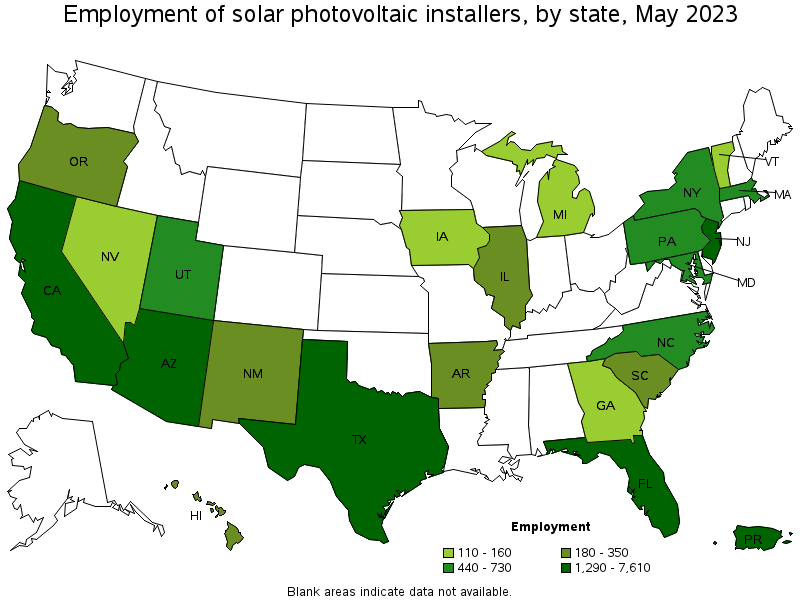
States with the highest employment level in Solar Photovoltaic Installers:
| State | Employment (1) | Employment per thousand jobs | Location quotient (9) | Hourly mean wage | Annual mean wage (2) |
|---|---|---|---|---|---|
| California | 7,610 | 0.42 | 2.63 | $ 27.26 | $ 56,700 |
| Texas | 3,460 | 0.26 | 1.58 | $ 22.52 | $ 46,830 |
| Florida | 1,690 | 0.18 | 1.10 | $ 23.38 | $ 48,630 |
| Arizona | 1,490 | 0.48 | 2.96 | $ 24.73 | $ 51,440 |
| New Jersey | 1,460 | 0.35 | 2.16 | $ 30.41 | $ 63,250 |

States with the highest concentration of jobs and location quotients in Solar Photovoltaic Installers:
| State | Employment (1) | Employment per thousand jobs | Location quotient (9) | Hourly mean wage | Annual mean wage (2) |
|---|---|---|---|---|---|
| Hawaii | 350 | 0.56 | 3.47 | $ 30.71 | $ 63,870 |
| Vermont | 150 | 0.49 | 3.01 | $ 26.37 | $ 54,850 |
| Arizona | 1,490 | 0.48 | 2.96 | $ 24.73 | $ 51,440 |
| California | 7,610 | 0.42 | 2.63 | $ 27.26 | $ 56,700 |
| Utah | 640 | 0.38 | 2.36 | $ 26.68 | $ 55,490 |
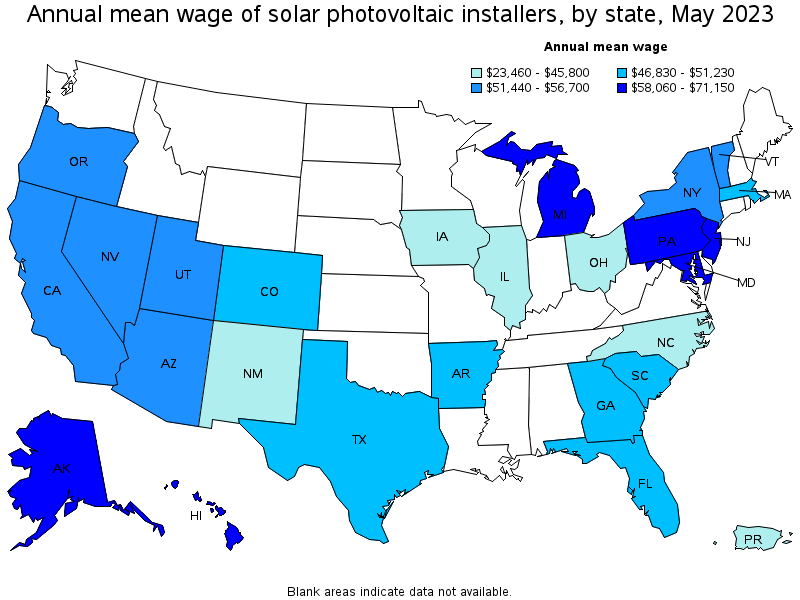
Top paying states for Solar Photovoltaic Installers:
| State | Employment (1) | Employment per thousand jobs | Location quotient (9) | Hourly mean wage | Annual mean wage (2) |
|---|---|---|---|---|---|
| Alaska | (8) | (8) | (8) | $ 34.21 | $ 71,150 |
| Michigan | 160 | 0.04 | 0.23 | $ 31.39 | $ 65,300 |
| Hawaii | 350 | 0.56 | 3.47 | $ 30.71 | $ 63,870 |
| New Jersey | 1,460 | 0.35 | 2.16 | $ 30.41 | $ 63,250 |
| Maryland | 620 | 0.23 | 1.44 | $ 28.05 | $ 58,340 |
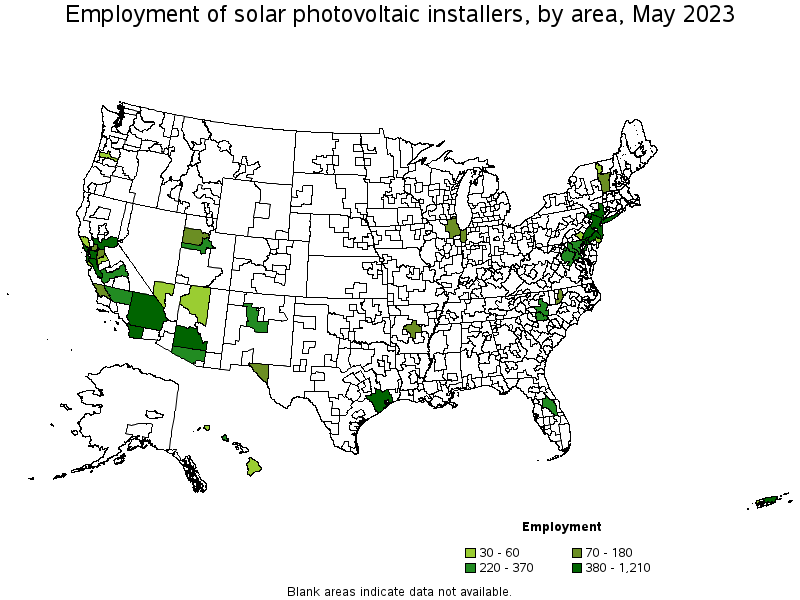
Metropolitan areas with the highest employment level in Solar Photovoltaic Installers:
| Metropolitan area | Employment (1) | Employment per thousand jobs | Location quotient (9) | Hourly mean wage | Annual mean wage (2) |
|---|---|---|---|---|---|
| New York-Newark-Jersey City, NY-NJ-PA | 1,200 | 0.13 | 0.78 | $ 30.96 | $ 64,390 |
| Phoenix-Mesa-Scottsdale, AZ | 1,100 | 0.48 | 2.97 | $ 25.59 | $ 53,220 |
| San Francisco-Oakland-Hayward, CA | 940 | 0.39 | 2.41 | $ 31.01 | $ 64,490 |
| Riverside-San Bernardino-Ontario, CA | 920 | 0.55 | 3.42 | $ 26.08 | $ 54,240 |
| Houston-The Woodlands-Sugar Land, TX | 900 | 0.28 | 1.75 | $ 23.54 | $ 48,970 |
| San Diego-Carlsbad, CA | 760 | 0.50 | 3.09 | $ 27.68 | $ 57,580 |
| Sacramento--Roseville--Arden-Arcade, CA | 690 | 0.66 | 4.07 | $ 26.56 | $ 55,240 |
| San Jose-Sunnyvale-Santa Clara, CA | 480 | 0.42 | 2.62 | $ 30.93 | $ 64,330 |
| Philadelphia-Camden-Wilmington, PA-NJ-DE-MD | 380 | 0.13 | 0.83 | $ 28.64 | $ 59,570 |
| Baltimore-Columbia-Towson, MD | 370 | 0.28 | 1.74 | $ 26.98 | $ 56,120 |
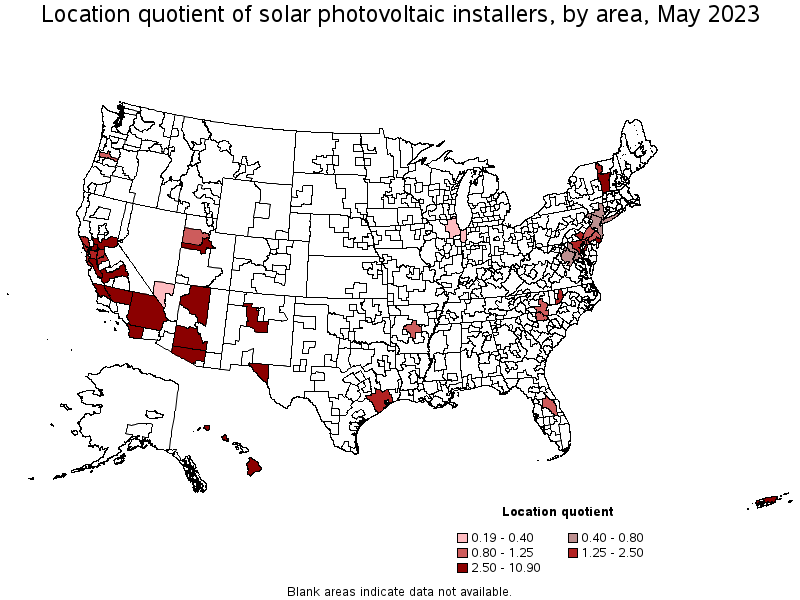
Metropolitan areas with the highest concentration of jobs and location quotients in Solar Photovoltaic Installers:
| Metropolitan area | Employment (1) | Employment per thousand jobs | Location quotient (9) | Hourly mean wage | Annual mean wage (2) |
|---|---|---|---|---|---|
| Bakersfield, CA | 300 | 0.90 | 5.59 | $ 25.46 | $ 52,950 |
| Provo-Orem, UT | 250 | 0.87 | 5.39 | $ 24.97 | $ 51,950 |
| San Luis Obispo-Paso Robles-Arroyo Grande, CA | 90 | 0.79 | 4.87 | $ 26.20 | $ 54,490 |
| Vallejo-Fairfield, CA | 100 | 0.70 | 4.35 | $ 24.73 | $ 51,450 |
| Sacramento--Roseville--Arden-Arcade, CA | 690 | 0.66 | 4.07 | $ 26.56 | $ 55,240 |
| Tucson, AZ | 240 | 0.61 | 3.80 | $ 22.57 | $ 46,950 |
| Fresno, CA | 240 | 0.58 | 3.60 | $ 26.12 | $ 54,320 |
| El Paso, TX | 180 | 0.56 | 3.50 | $ 26.33 | $ 54,760 |
| Albuquerque, NM | 220 | 0.56 | 3.46 | $ 20.94 | $ 43,550 |
| Riverside-San Bernardino-Ontario, CA | 920 | 0.55 | 3.42 | $ 26.08 | $ 54,240 |
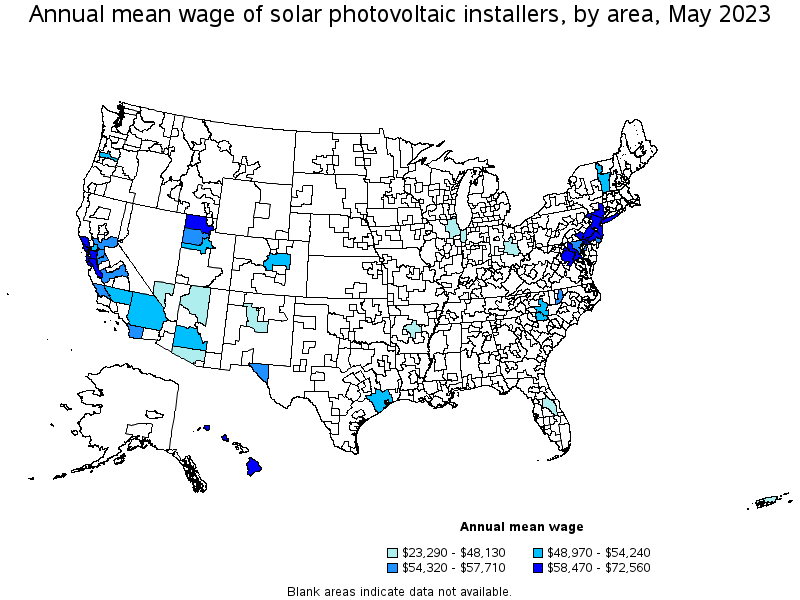
Top paying metropolitan areas for Solar Photovoltaic Installers:
| Metropolitan area | Employment (1) | Employment per thousand jobs | Location quotient (9) | Hourly mean wage | Annual mean wage (2) |
|---|---|---|---|---|---|
| Santa Cruz-Watsonville, CA | 30 | 0.34 | 2.08 | $ 34.89 | $ 72,560 |
| Urban Honolulu, HI | 240 | 0.55 | 3.39 | $ 31.42 | $ 65,350 |
| San Francisco-Oakland-Hayward, CA | 940 | 0.39 | 2.41 | $ 31.01 | $ 64,490 |
| New York-Newark-Jersey City, NY-NJ-PA | 1,200 | 0.13 | 0.78 | $ 30.96 | $ 64,390 |
| San Jose-Sunnyvale-Santa Clara, CA | 480 | 0.42 | 2.62 | $ 30.93 | $ 64,330 |
| Ogden-Clearfield, UT | (8) | (8) | (8) | $ 30.41 | $ 63,250 |
| Washington-Arlington-Alexandria, DC-VA-MD-WV | 330 | 0.11 | 0.66 | $ 30.05 | $ 62,500 |
| Lancaster, PA | 60 | 0.24 | 1.49 | $ 29.38 | $ 61,100 |
| Philadelphia-Camden-Wilmington, PA-NJ-DE-MD | 380 | 0.13 | 0.83 | $ 28.64 | $ 59,570 |
| Santa Rosa, CA | 60 | 0.31 | 1.91 | $ 28.11 | $ 58,470 |
Nonmetropolitan areas with the highest employment in Solar Photovoltaic Installers:
| Nonmetropolitan area | Employment (1) | Employment per thousand jobs | Location quotient (9) | Hourly mean wage | Annual mean wage (2) |
|---|---|---|---|---|---|
| Southern Vermont nonmetropolitan area | 90 | 0.85 | 5.24 | $ 25.88 | $ 53,830 |
| Hawaii / Kauai nonmetropolitan area | 50 | 0.46 | 2.84 | $ 28.87 | $ 60,060 |
Nonmetropolitan areas with the highest concentration of jobs and location quotients in Solar Photovoltaic Installers:
| Nonmetropolitan area | Employment (1) | Employment per thousand jobs | Location quotient (9) | Hourly mean wage | Annual mean wage (2) |
|---|---|---|---|---|---|
| Southern Vermont nonmetropolitan area | 90 | 0.85 | 5.24 | $ 25.88 | $ 53,830 |
| Hawaii / Kauai nonmetropolitan area | 50 | 0.46 | 2.84 | $ 28.87 | $ 60,060 |
Top paying nonmetropolitan areas for Solar Photovoltaic Installers:
| Nonmetropolitan area | Employment (1) | Employment per thousand jobs | Location quotient (9) | Hourly mean wage | Annual mean wage (2) |
|---|---|---|---|---|---|
| Hawaii / Kauai nonmetropolitan area | 50 | 0.46 | 2.84 | $ 28.87 | $ 60,060 |
| Southern Vermont nonmetropolitan area | 90 | 0.85 | 5.24 | $ 25.88 | $ 53,830 |
These estimates are calculated with data collected from employers in all industry sectors, all metropolitan and nonmetropolitan areas, and all states and the District of Columbia. The top employment and wage figures are provided above. The complete list is available in the downloadable XLS files.
The percentile wage estimate is the value of a wage below which a certain percent of workers fall. The median wage is the 50th percentile wage estimate—50 percent of workers earn less than the median and 50 percent of workers earn more than the median. More about percentile wages.
(1) Estimates for detailed occupations do not sum to the totals because the totals include occupations not shown separately. Estimates do not include self-employed workers.
(2) Annual wages have been calculated by multiplying the hourly mean wage by a "year-round, full-time" hours figure of 2,080 hours; for those occupations where there is not an hourly wage published, the annual wage has been directly calculated from the reported survey data.
(3) The relative standard error (RSE) is a measure of the reliability of a survey statistic. The smaller the relative standard error, the more precise the estimate.
(8) Estimate not released.
(9) The location quotient is the ratio of the area concentration of occupational employment to the national average concentration. A location quotient greater than one indicates the occupation has a higher share of employment than average, and a location quotient less than one indicates the occupation is less prevalent in the area than average.
Other OEWS estimates and related information:
May 2023 National Occupational Employment and Wage Estimates
May 2023 State Occupational Employment and Wage Estimates
May 2023 Metropolitan and Nonmetropolitan Area Occupational Employment and Wage Estimates
May 2023 National Industry-Specific Occupational Employment and Wage Estimates
Last Modified Date: April 3, 2024